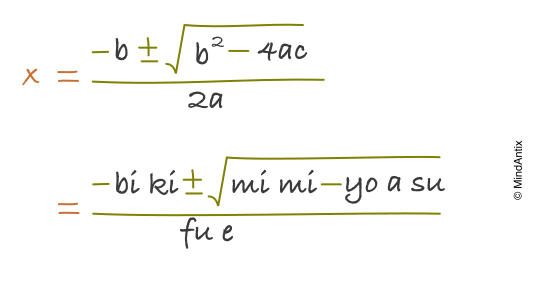On a visit to the Ryoyo Institute in Japan, a school that used experimental techniques to aid learning, Kenneth Higbee and his colleagues were quite impressed with what they saw. A group of kindergarteners were solving, not single digit addition problems, but quadratic equations of the form ax2 + bx + c = 0, a task that most adults find challenging!
The children were using the Yodai technique, a form of mnemonics created by Masachika Nakane, a teacher and principal at the Ryoyo Institute. Yodai, which means the “essence of structure”, uses rhymes, songs, stories and visual imagery to learn and remember the orderly steps in solving problems.
In this particular case, the children remember the formula for solving the equation by a mnemonic called the “flute song”. Each syllable of the song corresponds to a component of the formula (see picture above). As Emmanuel Manalo explains, “The song goes as follows: fu-e-no (“flute’s”), hi-bi-ki (“sound”), wa (topic marker which means “as for the previous”, mi-mi (“ear”), hi (which means to hold the previous sound when singing), yo-a-shi (“good”). In English, the song means “As for the flute’s sound, it is good to the ear.” ”
While mnemonics don’t help in understanding the subject matter, they are a helpful aide in mastering a subject. Sometimes knowing the “how” can be a stepping stone to understanding the “why”. Scruggs and Mastropieri, advocates of using Mnemonic Instruction in classrooms, found that “students with special needs performed substantially better on content that had been instructed mnemonically (36.7% vs. 75% correct).”
Mnemonics fall into two categories – fact mnemonics (used for remembering facts and also the more commonly known form) and process mnemonics (used for remembering rules and procedures).
Fact mnemonics include techniques like
- Keyword Method – The Keyword method is a useful tool to remember new vocabulary words. For example, to help remember a new word “barrister”, you can imagine a bear (keyword) acting like a lawyer.
- Pegword Method – Pegwords are rhyming proxies for numbers like one is bun, two is shoe and are useful for remembering numbered or ordered information. For example, a jury of elves (“elf” being a pegword for twelve) can help students remember that juries have 12 members.
- Letter Strategies – These include acronyms and acrostics and are useful for remembering lists. For example, “My Very Eager Mother Just Served Us Nachos” to remember the order of planets in the solar system.
Process mnemonics, on the other hand, help in remembering rules or procedures like the Yodai mnemonics. An example of a process mnemonic that helps to remembering the ordering of i’s and e’s is “an i before an e, except after c or when sounded like an a as in neighbor and weigh”.
The mNEWmonics category of MindAntix brainteaser adds a creative twist to the process of learning. The goal is to come up with a new mnemonic to help memorize a fact or a concept – either a new version of an existing mnemonic or a completely new one.
There are advantages to making your own mnemonic. When you create your own mnemonic, you create associations that work better for you, thereby building your own “memory tool”. Also, in the process of searching for a mnemonic, you end up revisiting the underlying content several times, further strengthening the connection.
So is there anything you wish you wouldn’t keep forgetting? Why not try making a mnemonic for it?

